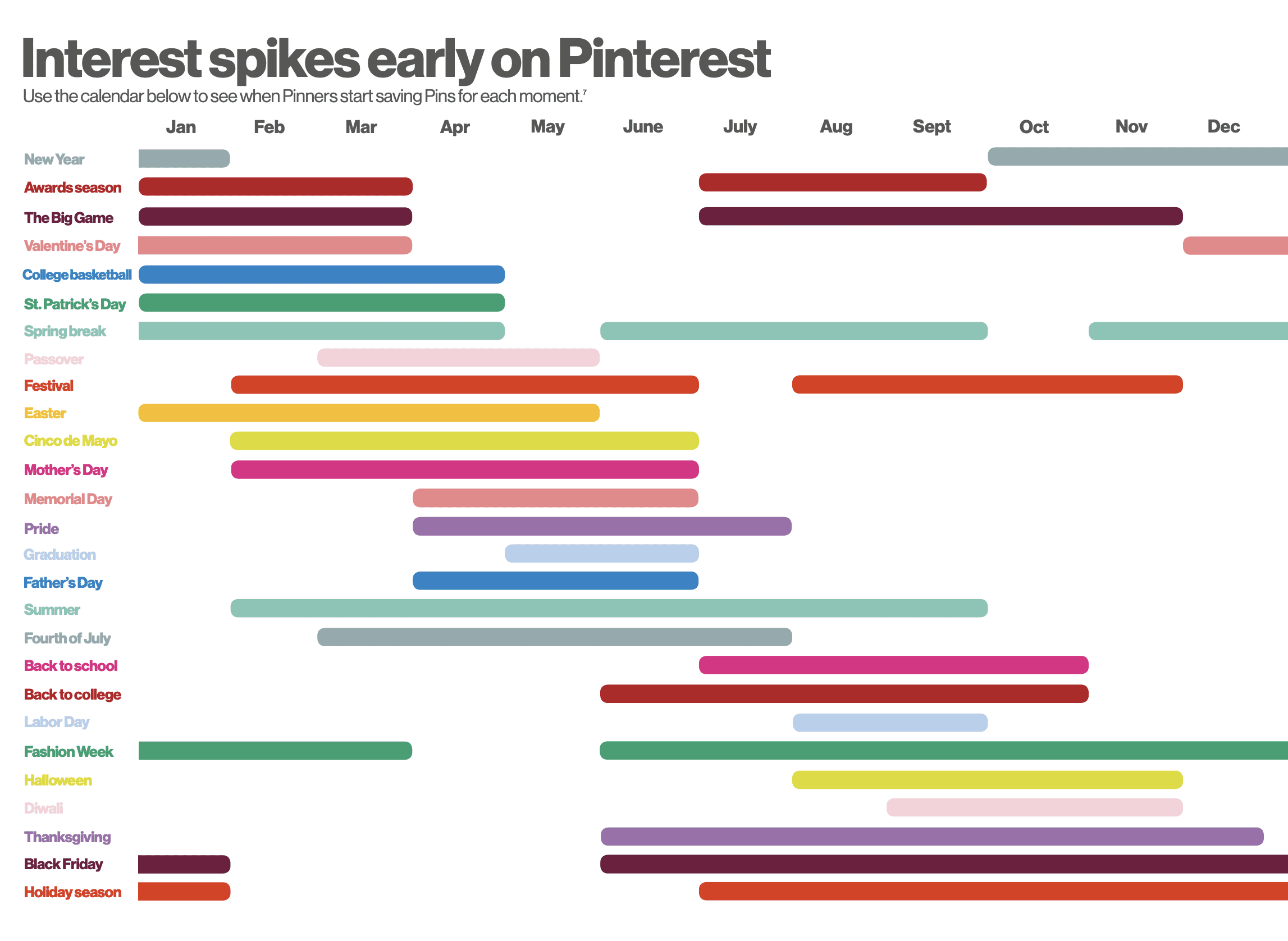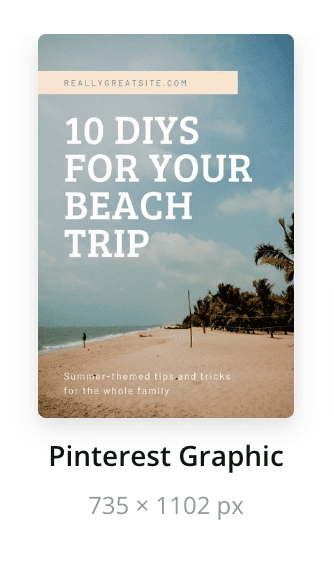One of the most powerful and effective social media channels you can be on today is Pinterest. It also happens to be the channel that drives some of the most curiosity.
We’re often asked:
How are brands and businesses succeeding on Pinterest today?
And how can you follow their playbooks to make waves yourself?
We were eager to get to the bottom of the Pinterest strategies that are working today, so we’ve done the research and added our findings here. We go deep on all things Pinterest marketing in this blog post. Join us as we explain the latest strategies, best content tips, and newest distribution tactics to help you get results on Pinterest and drive more engagement and clicks.
There are lots of people getting amazing results on Pinterest. We want you to be among them!
What makes Pinterest marketing so great
Did you know: Pinterest is the top social network for product discovery?
Did you know: More than half of Pinterest users have accessed Pinterest in a store while they’re shopping?
There might be a reason why these stats sound a bit new. Pinterest seems to fly under-the-radar when it comes to social media chatter. Instagram, Facebook, and Twitter steal headlines. Meanwhile, Pinterest keeps chugging away … 270 million active users, 280 million, 290 million …
One of the questions we get asked most often is what strategies are working on Pinterest?
Or, put another way …
I’ve heard Pinterest is great. But I don’t understand how!
We were curious ourselves to find out the specific strategies that drive engagement and ROI on Pinterest. We want to put them to use for our Buffer Pinterest profiles and to share them with you so you can do great things on Pinterest.
First, let’s set the scene by talking about one of the biggest topics on Pinterest: demographics.
Yes, it’s true that Pinterest’s demographics are uniquely weighted in comparison with other social networks. We ran through social media stats and facts in episode number 150 of the podcast. Here’s what we shared about Pinterest …
In the U.S.
- 41% of women who are online use Pinterest. Meanwhile
- 16% of online men use Pinterest
And in terms of age breakdown, the majority of Pinterest users fall between 18
- 34% of 18-29 year olds use Pinterest and
- 34% of 30-49 year olds use Pinterest
So while the specific demographics skew female and a bit older than other social networks, there’s another lens that’s worth taking a look through.
Pinterest is the number one platform for product discovery.
If you sell a product, Pinterest is a place for you.
This is due to a number of factors. Pinterest, along with Instagram, is an incredible visual marketing platform, and products lend themselves well to visuals. Pinterest has e-commerce tools built into the platform, too, for shopping and learning more about products.
And Pinterest is incredibly well indexed for search both in the Pinterest app and on Google.
So with this background and encouragement in mind … we have some tips from some of the top marketers and direct-to-consumer brands on Pinterest that you can apply to your Pinterest strategy today.
The 7 best Pinterest tips and strategies that are working today
1. Make a 6- to 15-second video.
Brands have been posting video to Pinterest for a couple years now, so we’ve had the chance to see the trends and pull the data. According to Pinterest, the best videos are the shortest ones. The sweet spot is 6- to 15-second videos.

Along with length, there are a couple of other things to watch for to make sure your video gets views.
- First, don’t rely on audio to get your message across. Just like we’ve seen on Facebook, Instagram, and Twitter, a lot of social media users browse their feeds with the sound off. If you’re using a video on Pinterest, be sure to have the visuals speak for themselves, or use captions or text overlay to explain your message.
- Once you’ve uploaded your video, be sure to pick a strong cover image to show up in the feed. Remember: your video will be competing with the beauty and vivacity of a screen full of Pinterest visuals. It needs to be good!
- Make sure the visual is on-message. Pinterest uses the cover image to help show your video to the right audience.
- Pinterest says that the best videos are storytelling videos and how-tos. Hunter, a rain gear brand, saw a 30% increase in branded searches when they used Pinterest video for a launch. It works!
2. Optimize your Pinterest ads with the Pinterest Tag
You have the Facebook pixel installed, right?
You’re using Twitter’s, too?
Well If you’re serious about making Pinterest ads work, then you’ll want to get the Pinterest Tag installed also.
Just like the other social network trackers, the Pinterest Tag allows you to follow the behavior of people who click from one of your Pinterest ads and come to your website. You can see how they navigate through your website and whether or not they convert.
The best brands are using this data just like you would with your Facebook, Instagram, and Twitter data — you can use it to measure the performance and ROI of your ads and improve your targeting for the future ads you run.
While you’re at it, be sure to install Enhanced Match also. With the Pinterest Tag you can track the conversion of most of your audience; and with Enhanced Match, you have the chance to capture even more — like situations when cookies aren’t present.
And just like with other social ads, to get the best returns on your ad spend, you want to think holistically about the entire customer journey.
In short, you want the message of the ad to match the message of the landing page.
On Pinterest, you can achieve this with the descriptions you write for your pins … but an even better place is in the text overlay of the image. Text overlay is simply the text that you put into the design of your image, whether you’re creating it in Canva, Photoshop, Sketch, or elsewhere.

Oh, and this might go without saying in 2019 … but be sure that your landing page is mobile-friendly! Especially when you’re running ads for mobile and tablets.
3. Break out that calendar. Seasonal moments are among the best times for brands on Pinterest.
Pinterest is one of the go-to places for planning, so the network sees an especially sharp uptick in usage around big moments. Say, a Super Bowl party or Thanksgiving or New Year’s … these calendar spots are opportunities for you to get in front of an even bigger audience and to maximize your reach and resources.
Pinterest has a downloadable“possibilities planner” that covers a bunch of these seasonal moments.

The guide is great because it doesn’t just give you a single date for each moment. It tells you when Pinners start saving Pins, often months ahead of the specific date.
For instance, here are the moments that begin around July:
- Back to School
- Back to college
- the holidays
And if you want to catch Black Friday vibes, better hurry. Those moments began in June!
4. Get the basics right.
To refresh, here are the technical specs for exactly what size, shape, and style to use for your Pinterest creative. Your Pinterest content will do best if it’s optimized for Pinterest.
The ideal aspect ratio for a Pin is 2:3.
This means a tall image, for instance a 1000-pixel-by-1500-pixel image. To calculate aspect ratio, you should be able to divide the width by two and the height by three and end up with the same answer. For instance, in our 1,000-by-1,500 example, the division would have got us to 500.

- The max file size is 10 megabytes in a JPG or PNG format.
- You get 100 characters for a pin title
- You get 500 characters for the pin description.
It’s important to note: the first 50-60 characters of the description are likely to show up in the feed. Use that space wisely!
And while it might not be named specifically in the Pinterest guidelines, you can upload animated GIFs to Pinterest for some added zest, humor, or engagement.
Switching gears to video, here are the sizes and shapes of ideal Pinterest video:
- a maximum length of a 15 minutes
- a minimum length of 4 seconds. (Remember from earlier that the best-performing length is somewhere between 6 and 15 seconds.)
The file itself can be an .mp4 or a .mov but the size must be less than 2 GBs
A couple of different shapes work best — basically, just not wide, landscape videos. We’ll get to those in a second. Pinterest recommends square videos — a 1:1 aspect ratio — or vertical video at a 2:3 aspect ratio or a 9:16 aspect ratio.
5. Try max-width video ads .. plus all the other new ad types that Pinterest has to offer
Pinterest has a couple different ways that video can show up in the feed. There’s the standard-width video — these are the ones we just discussed, where they can be either square or vertical.
There’s also what’s called max-width video. And wow, these are eye-catching. They span the width of two columns in the Pinterest grid. Here’s where you can really embrace your widescreen — Pinterest allows the horizontal, widescreen videos for this format, as well as square videos. No vertical video.
These videos can be great ads for launches or new releases. One of our favorite examples of this was from the movie The House With a Clock In Its Walls, which used the max-width video ads as part of its launch campaign.
We’re big proponents of trying out the latest ad types whenever social networks release something. So definitely give max-width ads a spin.
Also, check out Pinterest carousel ads. You can create carousels that are organic or paid, and these feature two to five images, either at a square or vertical size.
For a special nudge toward giving Pinterest ads a try, we found this stat from Carnival Cruise’s Pinterest campaigns: They saw 31% lower costs per click on Pinterest than on other platforms.
6. Use the right hashtags
Pinners use hashtags to find trending topics and to index and search the site. Unlike other networks, Pinterest hashtags aren’t necessarily funny or tongue-in-cheek — they’re best used when they’re descriptive and specific.
You can use up to 20 hashtags in your description, and if you’re stuck on what to use, Autocomplete is a great way to find the right hashtags to add. To check Pinterest’s Autocomplete, simply go to the Pinterest search bar and start typing. Whatever Pinterest suggests is likely to be a high-volume keyword.
7. Check out the latest Pin Trends report to see what’s working right now
Every month, Pinterest publishes the latest data-backed findings of what’s popular on Pinterest right now. They just released their July report. You can find all the previous months and coming months at their website.
These reports get super specific. Here’s a sampling of what Pinterest shared in July:
- Searches for“bubble waffles” are up 55 percent year-over-year
- Searches for pastel yellow interiors are up 73 percent year-over-year
- Searches for bracelet handbags are up 150 percent
Pinterest groups these findings into categories about food, fashion, home, and lifestyle. Additionally, they share specific insights for regions like Australia, France, the UK, Canada, and more. For instance, in the U.S. in July, searches for jalapeno frozen margaritas are up 139%. Who knew!
Proceed with caution: Joining group boards
The way this one works is that you find a board that’s really popular, and you reach out that board to see if they’d be interested in having you contribute. Of course, you’ll want to choose a board that fits your niche and that you sincerely want to contribute useful, meaningful content.
Where this strategy has gone off the rails is when it’s been used as an inauthentic growth tactic. Pinterest is wise to this and has issued statements about the right and wrong ways to post.
The result is that, in general, group boards have been receiving less exposure in the feed than content from personal boards.
So if you find a group board that’s firmly in your brand’s wheelhouse, by all means jump on in and contribute. But if you’re only in it for the views and clicks, then we suggest trying out any of these other strategies that we’ve named instead.
How to say hello to us
We would all love to say hello to you on social media – especially Twitter!
- Heather-Mae on Twitter
- Dave on Twitter
Thanks for listening! Feel free to connect with our team at Buffer on Twitter, Buffer on Facebook, our Podcast homepage, or with the hashtag #bufferpodcast.
Enjoy the show? It’d mean the world to us if you’d be up for giving us a rating and review on iTunes!
—
About The Science of Social Media podcast
The Science of Social Media is your weekly sandbox for social media stories, insights, experimentation, and inspiration. Every Monday (and sometimes more) we share the most cutting-edge social media marketing tactics from brands and influencers in every industry. If you’re a social media team of one, business owner, marketer, or someone simply interested in social media marketing, you’re sure to find something useful in each and every episode. It’s our hope that you’ll join our 27,000+ weekly iTunes listeners and rock your social media channels as a result!
The Science of Social Media is proudly made by the Buffer team. Feel free to get in touch with us for any thoughts, ideas, or feedback.
Try Buffer for free
190,000+ creators, small businesses, and marketers use Buffer to grow their audiences every month.



